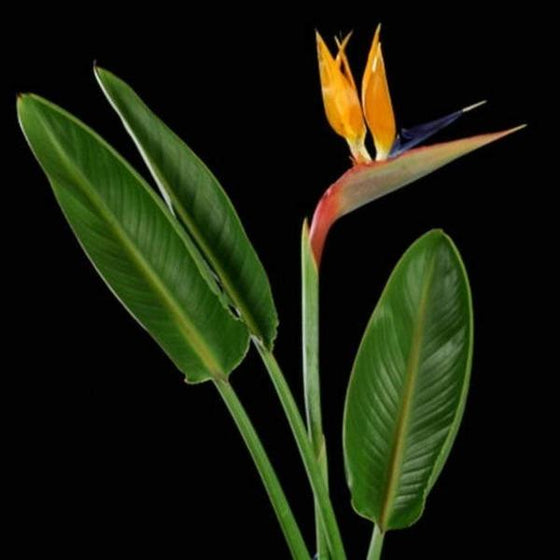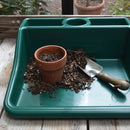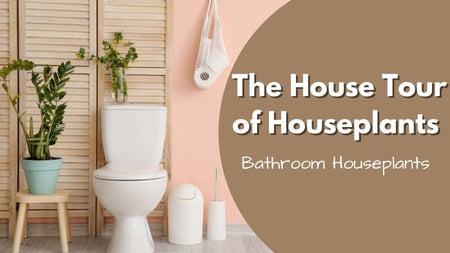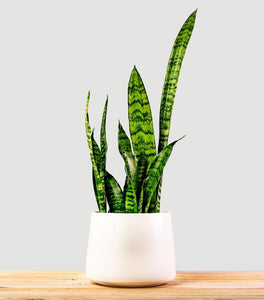
Images Depicted Range in Maturity & Container Size
Pots & Decorations Not Included Unless Otherwise Stated
Orange Bird of Paradise: Tropical Drama, Indoors or Out
Iconic Orange-and-Blue “Bird” Blooms
The Orange Bird of Paradise plant is one of the most recognizable tropicals in the world. Its striking orange and cobalt-blue flowers emerge from boat-shaped, green bracts, resembling an exotic bird in flight perched above a fan of broad, paddle-shaped leaves. Even when it isn’t in bloom, Strelitzia reginae brings instant tropical drama with its bold clumps of upright foliage. In warm climates, it’s a landscape staple; in cooler zones, it shines as a long-lived container plant or large, architectural houseplant that turns any space into a resort-worthy retreat.
Clumping, Upright, and Architectural
Orange Bird of Paradise grows from a rhizomatous root system, forming dense clumps of thick stems topped with long, leathery leaves. In the landscape, mature clumps typically reach 3–5 feet in height and 3–4 feet in width, slowly expanding over time. In containers indoors, you can expect 3–6 feet in height with good light and care, making it an ideal “indoor tree” scale plant for living rooms, sunrooms, or bright offices. The growth is moderate and steady rather than fast, so it fills its space confidently without becoming unmanageable overnight.
Bright Light, Warmth, and Moist but Well-Drained Soil
To truly thrive and bloom, Strelitzia reginae requires ample light. Outdoors, it performs best in full sun to light shade; indoors, it prefers bright indirect light to several hours of direct sun, especially from a south- or west-facing window that it’s been gradually acclimated to. Plant it in a rich, well-draining potting mix—think high-quality indoor or outdoor container mix amended with perlite or bark—so water moves through freely and roots never sit in a soggy, airless medium.
Watering should keep the soil evenly moist but not waterlogged. Allow the top inch or so of the mix to dry before watering again, then water thoroughly until excess drains from the pot. During spring and summer, this typically means watering about once a week indoors, slightly more often in hot outdoor containers, and less frequently in winter when growth slows. Orange Bird of Paradise loves warmth (ideally 65–80°F) and appreciates moderate humidity; if leaf edges crisp in dry indoor air, occasional misting, a pebble tray, or grouping with other plants will help. Protect it from frost and cold drafts—plants in cooler zones should be brought inside before nighttime temperatures drop below the mid-50s.
Statement Plant for Patios, Poolsides, and Great Rooms
In the landscape, Orange Bird of Paradise is a natural focal point along pool sides, in entry gardens, and as a bold accent in tropical or Mediterranean-style beds. It pairs beautifully with palms, hibiscus, and other sun-loving tropical plants, as well as with grasses and succulents for a modern, tropical-inspired mix. In colder climates, use it in large containers on decks and patios all summer, then bring it indoors for the winter. As a houseplant, it’s a stunning statement next to picture windows, in sunrooms, or in double-height spaces where its tall stems and big leaves can really shine.
Do note that Bird of Paradise is considered toxic if ingested, with the fruit and seeds being of most concern, so it’s best to keep it out of reach of chewing pets and small children. With smart placement and the right light, you’ll enjoy years of lush foliage and, in time, those unforgettable orange-and-blue blooms.
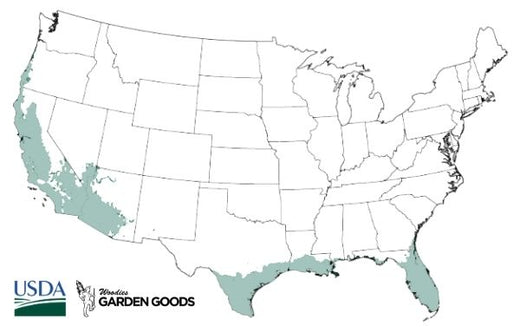
| Hardiness Zone: | 9-11 |
|---|---|
| Mature Height: | Indoors/containers: typically 3–6 ft tall |
| Mature Width: | 3–4 ft wide |
| Classification: | container or houseplant in cooler zones |
| Sunlight: | Full sun to light shade outdoors; bright indirect light to direct sun indoors when acclimated |
| Bloom Time/Color | Seasonal, often late winter through spring; orange and blue bird-like flowers |
| Soil Condition: | Rich, well-draining potting mix; loamy soil with added perlite or bark |
| Water Requirements: | Keep soil evenly moist but never soggy; let top 1" dry between waterings |
| Uses: | Focal container on patios, poolside accent, tropical border, large architectural houseplant |
How to Care for Orange Bird of Paradise
Before you buy an Orange Bird of Paradise, make sure to read about the recommended care instructions to keep this plant healthy and thriving.

How should I plant an Orange Bird of Paradise plant?
Choose a sturdy container with drainage holes—these plants get top-heavy as they mature—and fill it with a high-quality, well-draining potting mix. A rich indoor/outdoor container mix amended with extra perlite or chunky bark works well, ensuring good aeration around the roots. Gently remove the plant from its grower pot, loosen any circling roots, and position the root ball so the existing soil line sits level with or slightly above the new mix. Backfill around the roots, firming lightly to eliminate air pockets without compacting the soil. After planting, water thoroughly until excess moisture drains from the bottom of the pot, then allow it to finish draining before placing it in its decorative spot. Set your Orange Bird of Paradise where it will receive bright light—near a south- or west-facing window indoors, or in full sun to light shade outdoors. If moving a plant from indoors to full outdoor sun, acclimate it gradually over a week or two to avoid leaf scorch.
How often should I water Orange Bird of Paradise after planting?
Following that initial deep watering, allow the top inch or so of soil to dry out before watering again. Indoors in bright light, that often translates to watering roughly once a week during the growing season, but always adjust for your specific environment—warmer, sunnier rooms will dry faster, while cooler or lower-light spaces will dry more slowly. When watering, moisten the soil evenly until water exits the drainage holes, then discard any remaining water in the saucer. Outdoors in containers or in very warm, sunny rooms, you may need to water more frequently during hot spells to keep the root zone evenly moist. In fall and winter, reduce watering as growth naturally slows and light levels drop, allowing the soil to dry a bit more between drinks. Avoid letting the plant sit in soggy soil or standing water, as this can lead to root rot and yellowing leaves.
When should I fertilize Orange Bird of Paradise?
Orange Bird of Paradise is a relatively hungry plant when it’s actively growing. Feed it during spring and summer with a balanced, water-soluble fertilizer diluted to half strength every 4–6 weeks. Apply fertilizer onto moist soil—ideally right after a regular watering—so nutrients disperse evenly through the mix without burning the roots. This feeding schedule supports lush foliage and encourages flowering in plants that are mature and well-lit. In fall and winter, pause or greatly reduce fertilizing as the plant shifts into a slower growth phase. Over-fertilizing during low-light months can lead to salt buildup in the soil and contribute to leaf tip burn. If you prefer organic options, a combination of compost, slow-release organic pellets, or occasional seaweed/fish emulsion during the growing season will gently feed the plant while also improving soil structure.

What is the best light for Orange Bird of Paradise?
Pruning Bird of Paradise is mostly about grooming and keeping the clump tidy. Use clean, sharp pruners to remove any yellowing, torn, or completely brown leaves at their base, cutting as close to the soil line as you can without damaging nearby stems. Spent flower stalks can be cut out the same way once the blooms fade and stalks begin to dry. This clean-up helps direct the plant’s energy into healthy foliage and new flower production. If the clump becomes overly dense or you want to rejuvenate an older plant, you can remove some of the oldest, most crowded stems at the base in late winter or early spring. Very mature clumps can also be divided at the root level, separating sections with several healthy stems and roots and potting them individually. Avoid heavy pruning of green, healthy foliage strictly for size control; instead, manage overall size by choosing an appropriately sized container and giving the plant enough light so it stays sturdy and upright.


